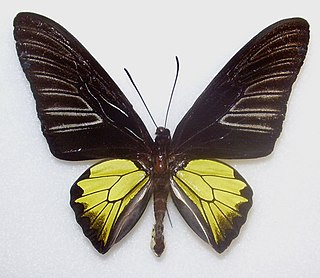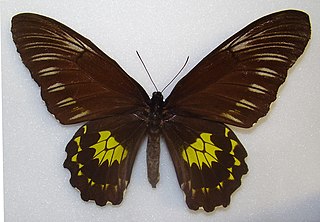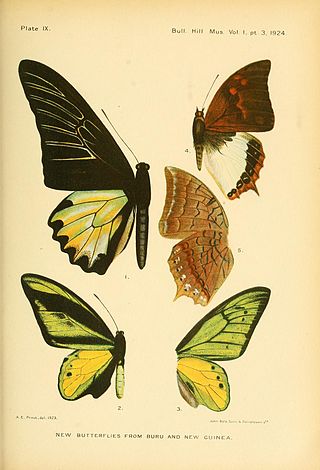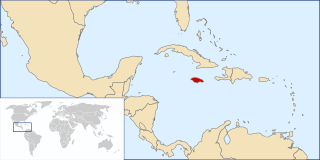
Danaus, commonly called tigers, milkweeds, monarchs, wanderers, and queens, is a genus of butterflies in the tiger butterfly tribe. They are found worldwide, including North America, South America, Africa, Asia, Indonesia and Australia. For other tigers see the genus, Parantica.

Troides rhadamantus, the golden birdwing, is a birdwing butterfly that inhabits the Philippines. The species was first described by Hippolyte Lucas in 1835. There are many subspecies on islands of the Philippines and some authors consider Troides plateni and Troides dohertyi as subspecies of T. rhadamantus.

Troides miranda, the Miranda birdwing, is a birdwing butterfly that inhabits Borneo and Sumatra.

USS Amycus (ARL-2) was one of 39 Achelous class landing craft repair ships built for the United States Navy during World War II. Named for Amycus, she was the only US Naval vessel to bear the name.

Troides prattorum, the Buru Opalescent Birdwing, is a species of butterfly in the family Papilionidae. It is endemic to Buru in the Maluku Islands of Indonesia.

Urania sloanus, or Sloane's urania, was a species of moth of the family Uraniidae endemic to Jamaica. It was last reported in 1894 or 1895, but possibly survived until at least 1908. The species was first described by Pieter Cramer in 1779.
John Cramer was an American lawyer and politician who served two terms as a United States representative from New York from 1833 to 1837.

Syntomoides imaon, the handmaiden moth, is a moth of subfamily Arctiinae, subtribe Ctenuchina. The systematics of the subfamily has been revised. It was described by Pieter Cramer in 1780. It is well distributed in Sikkim, Khasi hills and throughout India Tamil Nadu, Kerala, Sri Lanka, Myanmar, Bangladesh, Nepal, and Hong Kong, Viet Nam.

Autochloris is a genus of moths in the subfamily Arctiinae.

55576 Amycus is a centaur discovered on 8 April 2002 by the NEAT at Palomar.

Trigonodes hyppasia, the triangles or semi-looper, is a moth in the family Erebidae. The species was first described by Pieter Cramer in 1779. It is largely cosmopolitan, found throughout Borneo, Fiji, India, Nepal, Sri Lanka, São Tomé and Príncipe, Taiwan, Thailand, Zimbabwe, northern Australia, and almost all African countries.

Trigonodes cephise is a moth of the family Noctuidae first described by Pieter Cramer in 1779. It is found from the Indo-Australian tropics to northern Australia, the Caroline Islands, Samoa and New Caledonia, Nias and other islands on the south-west of Sumatra.

Appias epaphia, the diverse white or African albatross, is a butterfly of the family Pieridae. It is found in Africa, south of the Sahara. The habitat consists of forests and heavy woodland.

Feschaeria meditrina is a moth of the Castniidae family. It is known from Brazil. It is often treated as a subspecies of Feschaeria amycus.

Feschaeria amycus is a moth in the Castniidae family. It has been recorded from Guyana, Brazil, Venezuela and Tobago.













